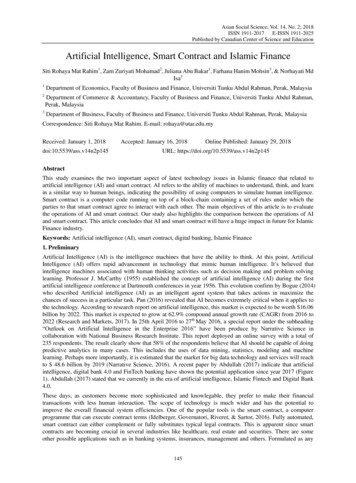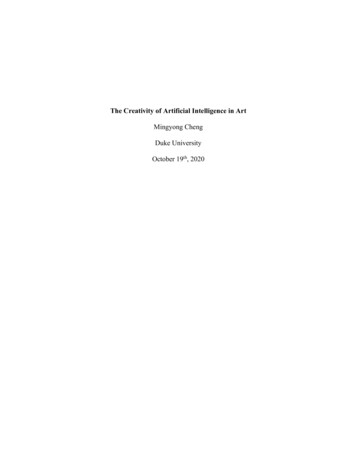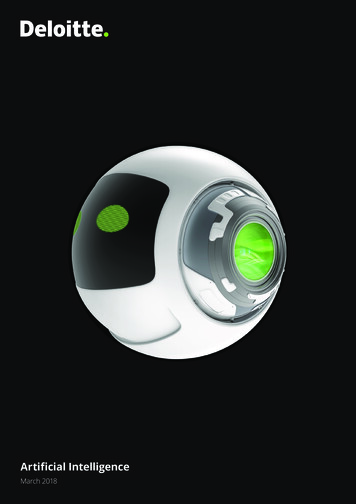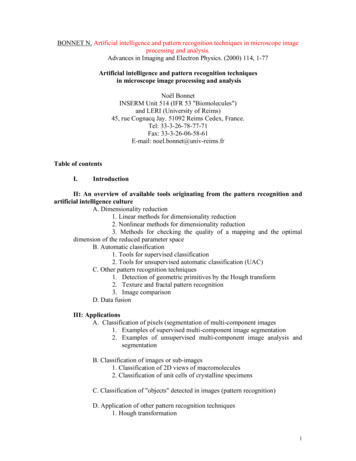
Transcription
STATE OFARTIFICIALINTELLIGENCEFORENTERPRISES1
TABLE OF CONTENTSEXECUTIVE SUMMARY.3KEY FINDINGS.5AI INVESTMENT AND ROI.7BARRIERS TO AI ADOPTION AND STRATEGIES TO SUCCEED. 16METHODOLOGY. 24State of Artificial Intelligence for Enterprises2
EXECUTIVE SUMMARYBusiness leaders looking for increased revenue, more efficiency and a better experience for theircustomers can have all of that — if they adopt artificial intelligence (AI) for their organization.That is the promise of AI that many businesses are actively investing in today.The hype evident in the commercial sector, from self-driving cars to speech-based personalassistants, is spilling over to the business world. AI is pivoting from a long-promised business solutionto a real-world spark that’s igniting change. Disruption is happening right now, and it’s moving veryfast. But, the big challenge for enterprises is figuring out the best strategy for creating value fromtoday’s AI investments, and recognizing, and avoiding, the landmines along the way.Through a survey conducted in July 2017 by Vanson Bourne, the Teradata “State of ArtificialIntelligence for Enterprises” report captures the here and now for AI — how executivedecision-makers are investing in AI today, the expected return on investment (ROI), whatbarriers lie ahead and how businesses craft a solid game plan to realize AI’s full potential.Our survey found a healthy dose of enthusiasm for AI, with 80 percent of enterprises reportingthey are already investing in some capacity in related technologies and 30 percent planning onexpanding their investments over the next 36 months. Businesses expect AI to keep them aheadof the competition in their industry. They are positioning AI so it can create sweeping gainsFor the purposes of thisreport, AI is the abilityto automate enterprisedecisioning usinghuman-to-machinecognitive interactionswhere machines are ableto augment and assisthuman capabilities bysensing and continuouslylearning, reasoning andinferring, and decidingand acting to drive abusiness outcome.across nearly all of their revenue streams and throughout their business practice areas. In otherwords, and not surprisingly, businesses are bullish on AI.But, success is going to take a concerted strategy.Almost all respondents (91 percent) anticipate significant barriers to adoption. The majoritypredict roadblocks due to lack of IT infrastructure (40 percent), followed by a lack of in-housetalent (34 percent). Just as many, 33 percent, claim that AI technology available today is toounproven and nascent, while 30 percent yearn for more budget. However, skepticism is lowerreport that some form of AI is alreadyin production in their organization.in other areas — only 19 percent are concerned that AI has a weak business case, and only 20percent worry about the impact of AI and automation on jobs and employee morale.State of Artificial Intelligence for Enterprises3
EXECUTIVE SUMMARY — CONTINUEDCompanies will overcome these barriers with more executive-level awareness and anenterprise-wide strategy for AI implementation and use. This is ushering in a shift within theC-suite: Today, AI strategy is typically under the scope of a CIO or CTO, but, in the near future,the majority of businesses surveyed plan to install a dedicated Chief AI Officer to lead the effort.Enterprises also realize that in-house talent that can harness AI is going to remain in short supply.So, businesses plan to create AI-driven opportunities and wins instead through vendors that willhelp them buy, build and deploy AI solutions.This survey proves that business leaders realize that the benefits of AI today are undeniable —and it will continue to prove itself as a powerful investment for the future, with executivesexpecting ROI to double in five years and triple in 10 years. But, to maximize its potential,business leaders must re-imagine how AI will exist in their enterprise. It has the capacity todisrupt all areas of a business, from the boardroom down to the data center. Adopting a clearand agile strategy will help these decision-makers realize AI’s potential by delivering newinsights, creating efficiencies and innovating faster than the competition.State of Artificial Intelligence for EnterprisesALMOST ALLRESPONDENTS(91 PERCENT)ANTICIPATESIGNIFICANTBARRIERS TOADOPTION4
KEY FINDINGSWith 80 percent of IT and business decision-Enterprise Investments:makers reporting they are currently using AIand 30 percent saying they plan to ramp upspending on AI technologies over the next 36months, this survey highlights enthusiasm forAI in enterprises today, a growing commitmentto new investments, and optimism that AI willimprove business practices and outcomes. 80 percent of respondents report that some form of AI is already in production in their organization,although 42 percent say that there is room for further implementation across the business. Companies expect a 1.23 ROI in the next three years for every dollar invested in AI today, 1.99 inthe next five years and 2.87 in ROI over the next 10 years. 30 percent still believe that their organization isn’t investing enough and will need to invest more inAI technologies over the next 36 months to keep up with competitors in their industry.While challenges will exist for enterprises asthey shift to a new business strategy poweredby AI, this report finds that they will acceptthose challenges, because the long-termbenefits clearly outweigh near-term pains.These near-term pains include significantinvestment in IT infrastructure and processes,time commitment to training workforce onAI, and potential impact on employee morale.Challenges: 91 percent expect to see barriers to AI realization. Top barriers to AI are a lack of IT infrastructure (40 percent) and lack of access to talent andunderstanding (34 percent). Only 28 percent of respondents recognize that their organization has enough trained peopleinternally to buy, build and deploy AI.Nevertheless, C-level executives — namely CIOsand CTOs — maintain they they are committedto AI in their enterprise, because of theStrategies:expected ROI over the next 10 years. Enterprises currently align AI strategy under traditional C-suite roles, with CIOs (47 percent) andCTOs (43 percent) leading in prevalence.The key findings of this report depict the However, 61 percent of respondents say they plan to hire Chief AI Officer in the futurecurrent state of AI adoption, its barriers toadoption and how businesses plan to AI is not perceived to be a growing threat to workers by 2030, with only 21 percent of respondentsprojecting AI will replace humans for most enterprise tasks in their organization.strategize to extract ROI.State of Artificial Intelligence for Enterprises5
SURVEY DEMOGRAPHICSRespondent Region260 IT and business decision-makers VP-level or higher fromorganizations with a global revenue of more than 50 million a yearwere interviewed in July 2017. They were split in the following ways:Respondent TypeOrganization SectorIT, technology & telecomsManufacturing & productionRetail, distribution & transportFinancial servicesBusiness & professionalservicesPublic sectorPrivate health care & servicesAmericasEuropeAPACFigure D1: Analysis showingrespondent region, displaying datafrom all respondents (260)State of Artificial Intelligence for EnterprisesIT decision-makersBusiness decision-makersFigure D2: Analysis showing therespondent type, displaying data fromall respondents (260)Other commercial sectorsFigure D3: “Within which sectoris your organization?” asked to allrespondents (260)6
AI INVESTMENT & ROI7
CURRENT AIINVESTMENTSAI has a robust adoption rate among those surveyed. Eighty percentof respondents report that some form of AI is already in productionin their organization, although 42 percent say that there is a lot of roomfor further implementation across the business. While APAC has madethe most current investments, both the Americas and Europe weremore likely to report more room for further investment.80%TotalAmericasEuropeAPACYes, we’d consider it to be in significant use across the business and is deployed operationallyYes, but there is lots of room for further implementation and process integrationNot yet, but we are researching this and plan to in the next 12 monthsNot yet, but we plan to in the next 24 monthsFigure 1: “Does your organization have any AI capabilities currently in production?” split by respondent region, asked to all respondents (260)State of Artificial Intelligence for Enterprises8
Organizations are starting to drive revenue from AI across the board,with between 25 percent and 50 percent of respondents reportingincreases. The top three areas where businesses are driving revenueare product innovation/research and development, customer service,and supply chain and operations.REVENUE DRIVERSFROM AI TODAYProduct innovation/R&DCustomer serviceSupply chain & operationsSecurity & riskSalesMarketingAsset & capital managementFinanceNo area is driving revenue from AIFigure 2: “Which part of your organization is driving revenue from AI capabilities today?” asked to respondents whose organization currently has AI capabilitiesin production (209)State of Artificial Intelligence for Enterprises9
EXPECTED RETURNON INVESTMENTNext 3 yearsGlobally, companies expect a 1.23 ROI in the next three years for everydollar invested today, 1.99 ROI in the next five years and 2.87 in ROIover the next 10 years.Next 5 yearsNext 10 yearsFigure 3: Analysis showing the average return on investment in U.S. dollars that respondents expect their organization could see for every 1 spent on AI technologies in the above timeframes, asked to all respondents (260)State of Artificial Intelligence for Enterprises10
REVENUE DRIVERS FORAI BY REGIONDifferent regions have different revenue drivers related to AIinvestments. APAC respondents report much higher productinnovation/R&D, customer service, marketing, and asset and capitalmanagement ROI than the Americas and Europe. Europe leads insupply chain and operations, while the Americas leads ROI fromthe sales organization.1%Productinnovation/R&DCustomer serviceSupply chain andoperationsSecurity and riskSalesAmericasMarketingEuropeAsset and capitalmanagementFinance0% 0%*Other(please specify)1%0%No area isdriving revenuefrom AIAPACFigure 4: “Which part of your organization is driving revenue from AI capabilities today?” split by respondent region, asked to all respondents (260)State of Artificial Intelligence for Enterprises11
Respondents around the globe expect to see the positive impacts ofAI, particularly in service sectors. They expect to see negative impactsacross many sectors that currently are dominated by human-centricinteractions.POSITIVESECTORSIMPACTED BY AIIT, technology & telecomsIT, technology & telecomsIT, technology & telecomsIT, technology & telecomsBusiness &professional servicesBusiness &professional servicesBusiness &professional servicesFinancial servicesConsumer servicesConsumer servicesManufacturing& productionFinancial servicesFinancial servicesManufacturing& productionHealth careManufacturing& productionFinancial servicesBusiness &professional servicesConsumer servicesConsumer servicesNEGATIVEFigure 5: Analysis showing the top five most commonly selected sectors that respondents expect to see the most positively impacted by the future growth of AI,asked to all respondents (260)EducationEducationGovernmentMedia, leisure & entertainmentMedia, leisure& entertainmentMedia, leisure& entertainmentEducationRetail, distribution & transportGovernmentGovernmentConstruction& propertyConstruction& propertyHealth careHealth careHealth careEducationConstruction& propertyConstruction& propertyConsumer services; Media,leisure & entertainment (tied)Consumer services;Health care (tied)Figure 6: Analysis showing the top five most commonly selected sectors that respondents expect to see the most negatively impacted by the future growth of AI,split by respondent region. Asked to all respondents (260)State of Artificial Intelligence for Enterprises12
PLANNED AREAS FORINVESTMENTCustomer experience — toimprove the experience &engagement with customersProduct innovation — todevelop & bring moreinnovative products &services to marketWhile adoption rates are already high, respondents from around theworld say there is a lot of opportunity for future implementation.The top three areas that will drive business outcomes are customerexperience, product innovation and operational excellence. Across theboard, the APAC region rated all planned areas of investment higher.Operational excellence — tooptimize operationsincluding supply chain,business processes, etc.TotalAmericasRisk mitigation — to mitigaterisk of cyber attacks& fraudEuropeFinance transformation — totransform financial auditing,regulatory compliance &reportingAsset optimization — tooptimize assets includingequipment, IP & humancapitalAPACFigure 7: “Which of the following business outcomes drive your organization to invest in AI capabilities?” split by respondent region, asked to all respondents (260)State of Artificial Intelligence for Enterprises13
IMPETUS FORINVESTMENT:COST TAKEOUT VS.REVENUE GROWTHTotalAmericasBusinesses anticipate about a half-and-half split between revenueincreases and cost/efficiency savings from their AI investments. This isconsistent with projected ROI for three years out, which is also abouteven, though ROI in five and 10 years doubles and triples, respectively.The Americas are an outlier, believing revenue increases will outweighsavings, versus Europe and APAC, where the opposite is true.EuropeRevenue increase/business growthAPACIT decision-makersBusiness decision-makersCost takeout/gaining efficienciesFigure 8: “Which of the below is or would be more of a driver for AI investment in your organization?” split by respondent region and respondent type, asked toall respondents (260)State of Artificial Intelligence for Enterprises14
REVOLUTIONIZING THEBUSINESS THROUGH AIAcross the board, respondents say AI has the potential to revolutionizetheir businesses. They imagine it has the biggest potential to automaterepetitive tasks, deliver new strategic insights and automate areas ofknowledge work. APAC, far more than any other region, is looking forAI that can reduce the need for costly human resources.2%Automate repetitiveprocesses & tasks thatcurrently require humaninvolvementDeliver new, strategicinsights currently notavailable to businessdecision-makersAutomate areas ofknowledge work, reducingthe need for costlyhuman resourcesTotalInnovate faster & findnew market opportunitiesbefore the competitionAmericasEuropeCreate efficiences & drivedown operational costsChange the way ourcustomers engage withthe business2%3%Don’t knowAPACFigure 9: “What do you see as the biggest areas of potential for AI to revolutionize your business?” split by respondent region, asked to all respondents (260)State of Artificial Intelligence for Enterprises15
Thirty percent of all respondents still believe that their organizationisn’t investing enough and will need to invest more in AI technologiesover the next 36 months to keep up with competitors in their industry,despite a reported average spend on AI today of 19.1 million. Morerespondents from APAC are planning to ramp up spending than theAmericas and Europe.IS THE INVESTMENTENOUGH?TotalAmericasEuropeAPACIT decision-makersBusiness decisionmakersFigure 10: Analysis showing the percentage of respondents who believe that their organization needs to invest more in AI technologies over the next 36 months tokeep up with competitors in their industry, split by respondent region and respondent type, asked to all respondents (260)State of Artificial Intelligence for Enterprises16
BARRIERS TO AI ADOPTION& STRATEGIES TO SUCCEED17
Almost all (91 percent) respondents expect to see barriers to AIrealization when trying to implement it across their business. Lack ofIT infrastructure and lack of access to talent lead the challenges. TheAmericas is the only region where lack of budget for implementationedges out lack of infrastructure as the main barrier.BARRIERS TO AI40Lack of IT infrastructureLack of access to talent and understanding34AI technology is still nascent and unproven33Lack of budget for implementation30Complications around policies, regulations & rightsImpact on customer expectationsLack of dataLack of executive buy-in or alternative prioritiesTotalLead time to implementation is too longImpact on employee moraleWeak business case for AI technologiesAmericasEuropePrevious AI investments/proejcts have failed*Other (please specify)APACWe are not seeing/expecting to see any barriersFigure 11: “What barriers are you seeing or expecting to see when trying to achieve AI realization across your organization?” split by respondent region. Asked to allrespondents (260)State of Artificial Intelligence for Enterprises18
TALENT SHORTAGE IN AITotal55%The majority of global respondents are relying on vendors and partnersto have the skills to drive their business outcomes. Only 28 percentof respondents recognize that their organization has enough trainedpeople internally to buy, build and deploy AI. However, APAC’s datashows it has a much clearer path, with very few respondents saying theyhave neither vendors or in-house talent to deploy AI.AmericasEuropeAPACYes, we have trusted vendors and partners that will help us buy, build, and deploy AI technologies and solutionsYes, we have enough trained people internally to buy, build, and deploy AI technologies and solutionsNo, we do not have trained people internally or trusted partners to buy, build, and deploy AI technologies and solutionsDon’t knowFigure 12: “Does your organization have the necessary people skills to effectively use AI technologies to drive business outcomes?” split by respondent region. Askedto all respondents (260)State of Artificial Intelligence for Enterprises19
Only 8 percent of global respondents say a dedicated Chief AI Officeris responsible for AI development at present; however, APAC is alreadyemploying this position 17 percent of the time. Most global respondentsare using a more traditional C-suite role, like a CIO or CTO.WHO IS DRIVINGDEVELOPMENT OFAI TODAY?47%43%8%Chief InformationOfficerChief TechnologyOfficerChief ExecutiveOfficerChief Analytics Officer/Chief Data OfficerTotalChief DigitalOfficerAmericasChief OperationsOfficerEuropeChief AIOfficerChief MarketingOfficer*Other(please specify)Don’t knowAPACFigure 13: “Who is responsible for the development of the current AI strategy at your organization?” split by respondent region. Asked to all respondents. (260)State of Artificial Intelligence for Enterprises20
Globally, 61 percent of respondents report that they expecttheir organization to employ a Chief AI Officer in the future.APAC still plans on creating the most CAIO positions in thenext 12 to 24 months.RISE OF THE CHIEFAI OFFICERWe have someone in a similar role/the responsibility already sits underanother C-suite roleWe already employ one45%We plan to employ onein the next 12 months17%We plan to employ onein the next 24 monthsWe have no plans to employ oneTotalAmericasEuropeDon’t knowAPACFigure 14: “Do you expect your organization to employ a Chief AI Officer in the future?” split by respondent region. Asked to all respondents (260)State of Artificial Intelligence for Enterprises21
MOST POPULARANALYTIC TECHNIQUESBetween 70 and 81 percent of global respondents are seeingbenefits or anticipate benefits from having analytics techniques inproduction. While anomaly detection and robotic process automationlead, respondents perceived every popular analytical techniqueto be beneficial.Early warningComputer visionRecommender systemsAnomaly detectionSpeech recognitionRobotic process automationAlready doing this and seeing benefitsAlready doing this but are not yet seeing benefitsThink this would be beneficialDo not think this will be beneficialDon’t know enough about this technologyFigure 15: Analysis of the usage and perceived benefits of the above AI analytic techniques for respondents’ organizations, asked to all respondents (260)State of Artificial Intelligence for Enterprises22
As is the story for AI analytic techniques, the majority oforganizations are seeing benefits or expect to see benefitsfrom multiple AI capabilities in business. Intelligentworkflow and decision automation, data engineering, andanalytic operations are perceived to have the highest benefits.AI CAPABILITIESIN BUSINESSCognitive designIntelligent workflow &decisioning automationDeep learning & maching learningAnalytic operations at scaleData engineeringOther enabling capabilitiesincluding governance, security,legal & policyAlready doing this and seeing benefitsAlready doing this but are not yet seeing benefitsThink this would be beneficialDo not think this will be beneficialDon’t know enough about this technologyFigure 16: Analysis of the usage and perceived benefits of the above AI capabilities for respondents’ organizations, asked to all respondents (260)State of Artificial Intelligence for Enterprises23
While AI is a growing trend, it is not perceived to be a growing threatby business leaders, who don’t believe it will replace workers by 2030.Only 21 percent of respondents claim that AI will replace humans formost enterprise tasks in their organization. Respondents from theAmericas are significantly less likely to report AI is poised to replaceworkers versus those from APAC.THE FUTURE OF HUMANSAND MACHINES2%Total45%AmericasEuropeAPACAI and humans will co-exist, each performing tasks that are optimized to their specific strengthsAI will become integrated with humans, resulting in enhanced human capabilities to perform enterprise rolesAI will replace humans for most enterprise tasksHumans will be largely unaffected by AIDon’t knowFigure 17: “By the year 2030, what do you think is the most likely scenario when it comes to human-machine collaboration for your organization?” split by respondentregion. Asked to all respondents (260)State of Artificial Intelligence for Enterprises24
METHODOLOGYThis survey report is based on researchRespondents worked across various industries,conducted by Vanson Bourne, anincluding technology and telecommunicationsindependent specialist in market research(18 percent); manufacturing and productionfor the technology sector, on behalf of(17 percent); retail, distribution and transportTeradata, through an online survey(15 percent); financial services (15 percent);conducted throughout July 2017. It coveredbusiness and professional services (9 percent);260 interviews that were evenly split betweenpublic sector (7 percent); private healthsenior IT and business decision-makers VP-care and services (5 percent); and otherlevel or higher in the Americas, Europe andcommercial sectors (14 percent).Asia-Pacific regions who work for companieswith a global annual revenue of 50 million orFor more information on Vanson Bourne,more — 50 percent of the respondents workvisit www.vansonbourne.com.in leadership roles for large enterprises withglobal annual revenue of 1 billion or more. Allrespondents were qualified using a rigorousmulti-level screening process to ensure thatonly suitable candidates were given theopportunity to participate.State of Artificial Intelligence for Enterprises50% of the respondentswork in leadership rolesfor large enterprises withglobal annual revenue of 1 billion or more.25
Consumer services; Media, leisure & entertainment (tied) Media, leisure & entertainment Retail, distribution & transport Construction & property Education Consumer services; Health care (tied) Figure 5: Analysis showing the top five most commonly selected sectors that respondents expect to see the most positively impacted by the future growth .











